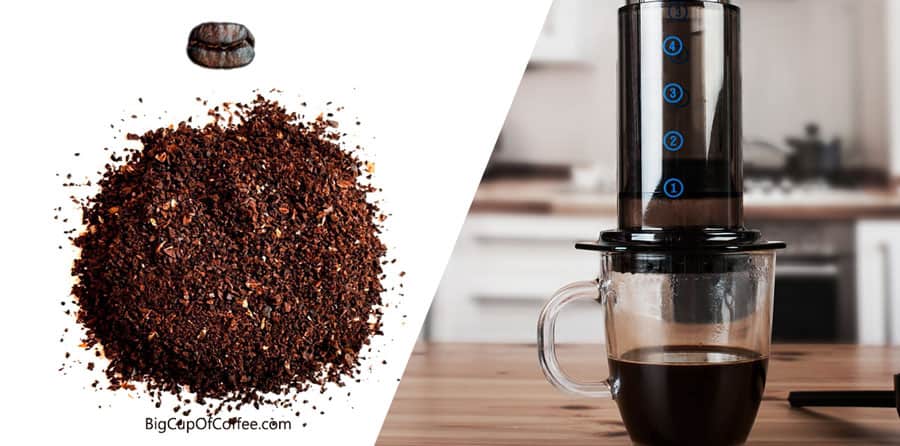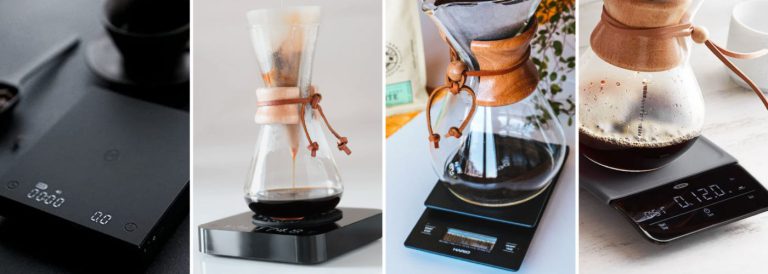AeroPress vs Chemex: Pro Barista’s View on Two Great Brewers
I find it fascinating how the AeroPress and Chemex are two marvelous brewers from different times. While the AeroPress is a brewing innovation invented only in 2005, the Chemex has been around since 1941 and has undoubtedly stood the test of time.
This made me wonder, which one’s better?
If you’re also wondering how the more recent brewer measures up compared to the classic that predates it for over 60 years, I’m here to give you an answer.
In this article, I’ll go in-depth as I discuss the factors that differentiate the AeroPress and Chemex to help you decide which one reigns supreme in your own kitchen.
Comparing AeroPress & Chemex – Which Method is Better?
So, which is better, the AeroPress or Chemex? It depends on what you’re looking for in your coffee.


The AeroPress offers a unique and innovative approach to brewing coffee. The process involves placing coffee grounds into a chamber, adding hot water, and then using a piston to force the water through the coffee grounds. This results in a rich and full-bodied cup of coffee you can enjoy at home or on the go.
On the other hand, the Chemex takes a more traditional pour-over approach. The manual brewing process (as described here) requires you to place a paper filter over the top of the hourglass-shaped glass and add coffee grounds. Then, slowly pour hot water over the grounds as it drips down into the carafe below. This creates a smooth and clean taste that many coffee enthusiasts appreciate.
Here are the factors to consider when picking between the two brewing methods, followed by a detailed comparison of each feature.
| Features | AeroPress | Chemex |
|---|---|---|
| Taste & Flavor | Rich and full-flavored with low acidity | Clean-tasting with a hint of sweetness |
| Strength | Wide range of strength options | Medium-strength intensity |
| Ease of Use | Quick and easy brewing, minimal mess | Pouring technique requires practice |
| Brewing Speed | 3-4 minutes | 5-7 minutes |
| Versatility | Unprecedented control over brewing process; limited coffee amount (10 oz or 8 oz for Go) | Decent control over brewing process; four size options (16 oz to 50 oz) |
| Durability & Portability | Lightweight and compact, ideal for travel | Glass construction, less suitable for travel |
| Sustainability | Plastic construction, recyclable paper filters | Glass construction, compostable paper filters |
| Cost | $30 to $40, ongoing cost for paper filters | $40 to $60, ongoing cost for paper filters |
Taste, Flavor, & Strength
The AeroPress and Chemex offer unique flavor experiences, and the better-tasting cup depends on your palate.
The AeroPress produces a rich and full-flavored cup of coffee with low acidity, while the Chemex boasts a clean-tasting cup with a hint of sweetness thanks to its thicker filter.
In terms of strength, the AeroPress offers a wide range depending on how much water you use or how long you steep your grounds. You can achieve light and delicate cups or bold and strong ones that rival espresso shots.
On the other hand, Chemex generally produces coffee with medium-strength intensity. This is perfect for you if you prefer sipping on milder coffee.
For me, I prefer AeroPress over Chemex mainly because of its rich flavor profile that isn’t too acidic. Plus, I really like experimenting with different recipes.
Ease of Use
When considering how easy the brewing method can be even for newbies, the AeroPress wins this category. It is designed for quick and easy brewing with minimal mess. Just place your filter, add your medium-fine ground coffee and hot water (175°F to 205°F), then press down on the plunger once extraction is completed – simple as that.
In contrast, while not difficult in itself, the pouring timing and technique can take some getting used to when using a Chemex. It involves putting medium-coarse ground coffee on the filter and skillfully pouring 200°F water temperature for optimal results. Once you’re past the pouring learning curve though, making great-tasting coffee on a Chemex should be no problem at all.
So if simplicity and time-saving are qualities that matter most to you when making coffee, then the AeroPress is probably your best bet. But if you don’t mind investing some learning time upfront to achieve great taste complexity and refinement- then opt for a Chemex instead.
To get the most out of these brewers, you will need a coffee scale, a good burr grinder, and a gooseneck kettle is a plus with the Chemex.
Brewing Speed
One thing that sets the AeroPress apart is its quick brewing time, which only takes 30 seconds up to four minutes depending on your desired recipe. Cleaning up is also pretty fast and easy, just rinse the plunger and chamber and you’re done.
As for the Chemex, brewing the coffee already takes 4 to 5 minutes and you also need to be more careful when cleaning because the brewer’s glass body can be prone to breakage.
In short, if the difference of a few minutes in making your coffee really matters to you, then the AeroPress may be your best match. But if you’re like many of us coffee geeks who have the extra few minutes and find comfort in your brewing ritual, then the Chemex isn’t really that bad in terms of speed.
Versatility
Having control over the brewing process is crucial if you want to experiment with different recipes and customize your cup according to your preferences.
Versatility is another strength of the AeroPress, providing unprecedented control over almost every aspect of the brewing process. With this method, you can adjust water temperature, grind size, brewing time, and pressure to create a personalized drink that suits your taste buds.
The Chemex also offers a decent level of control by allowing users to regulate grind size, water temperature, and pouring rate. However, it doesn’t offer quite as much versatility when compared to the AeroPress.
As for the flexibility of the coffee amount each brewing yields, Chemex takes the lead. It has four sizes that can cater to different needs:
- 3-cup (16 oz)
- 6-cup (30 oz)
- 8-cup (40 oz)
- 10-cup (50 oz)

Meanwhile, the AeroPress has a more limited capacity of 10 oz (290 ml), with the smaller AeroPress Go having an 8oz (230 ml) capacity and the new AeroPress XL with a 20oz (590 ml) capacity. So if you need to brew more coffee, the Chemex is the better choice.
Durability and Portability
While both are beautifully crafted, it’s hard to deny that the AeroPress is way more durable than the Chemex. Along with its sturdy plastic construction, the AeroPress is also incredibly lightweight and compact making it the ideal brewer for people who like to travel. On top of that, they recently released the AeroPress Clear which has a more durable Tritan plastic material.
To add to its durability, the AeroPress even rolled out a new variant with a more durable Tritan plastic material. Read my AeroPress Clear review to know more about it.
In comparison, while the Chemex is made with thermal shock-resistant borosilicate glass, it is still glass and can break if not handled carefully. Also considering its heavier weight, this is hardly something you want to take on a road trip where bumpy roads could easily spell disaster for your precious brewer.
So in this category, the AeroPress wins hands-down. I can attest to how this brewer can really be a convenient travel companion. Mine has tagged along with me through different states and it has not failed in making the coffee that suits my taste.
Sustainability
Sustainability in coffee is important because it ensures that we protect the environment while enjoying our favorite drink, and the brewer we use is an important factor here.
The plastic construction of AeroPress makes it less eco-friendly since it can be difficult to recycle. But it does use paper filters that are recyclable and compostable. Additionally, you can opt for reusable metal or cloth filters to really minimize unnecessary waste. Check out my comparative article on the AeroPress filter options.
On the other hand, Chemex is more eco-friendly due to its all-glass system with a wooden collar – both materials are renewable and biodegradable. Paper Chemex filters are also compostable, but they are larger and thicker than traditional paper filters. You can also get metal and cloth alternatives if you want to go super-green with a Chemex, but this alters the taste profile.
Regardless, when it comes to eco-friendly brewing, Chemex is the winner.
For more eco-conscious brewing options, you can also choose to use shade-grown coffee and recycle the grounds afterward to lessen your coffee waste.
Cost
When it comes to cost, the AeroPress and Chemex are fairly comparable. The AeroPress can be purchased for around $30 to $40, which is a reasonable price point for a high-quality coffee brewing device. However, it’s important to note that ongoing costs may include replacement paper filters – these cost around $0.02 each in 2024.
The Chemex, on the other hand, tends to be pricier at around $40 to $60 depending on where you’re buying it. That being said, its primary long-term expenditure concern is its disposable filter replacements priced at $0.16 per piece. That is 8x more than the filter of the Aeropress, but you can brew more coffee with it.
In terms of value for money, both devices offer great quality coffee without breaking the bank. Ultimately, it will come down to your personal preference on which one suits you better.
AeroPress and Chemex Weighing the Pros & Cons
Now that we’ve gotten a closer look at the features of each brewing method, here’s a quick overview of the pros and cons of AeroPress and Chemex so you can finally decide which one is for you:
| Brewing Method | Pros | Cons |
|---|---|---|
| AeroPress | – Highly portable – Versatile – Produces smooth and consistent coffee – Low acidity – Fast and easy to use and clean | – Limited capacity – The plastic body is not eco-friendly |
| Chemex | – A wide range of sizes – A clean and light cup of coffee – Attractive aesthetic | – The glass design can be fragile – Requires some learning curve – Needs additional effort for cleaning the inside of the carafe – Relatively expensive compared to other pour-over brewers |
You can also check out how AeroPress fares against other brewing methods such as:
And here are how brewers compare to the Chemex:
Conclusion
The AeroPress aces more factors including versatility, durability, brewing ease, and speed, while the Chemex has a wider range of sizes and is a more sustainable method. At the end of the day though, the better brewer between the AeroPress and Chemex depends on which factors you really give importance to.
For me, while I go for the AeroPress whenever I’m out or in need of a quick caffeine fix, I love how the Chemex offers a ritualistic approach. Plus, this classic brewer just looks great on my kitchen counter. As you can imagine, I use both brewers on occasion.
Which brewer do you prefer? Share your thoughts in the comments below.









